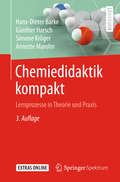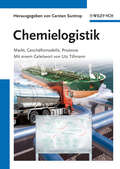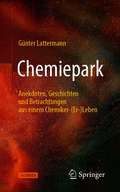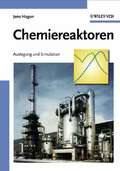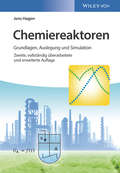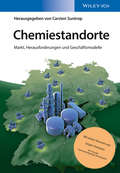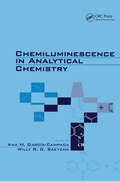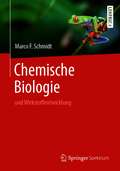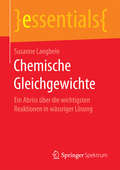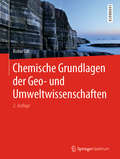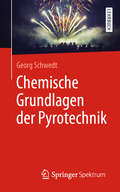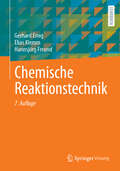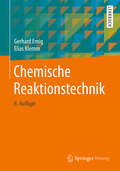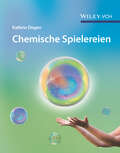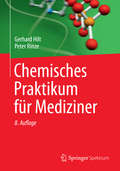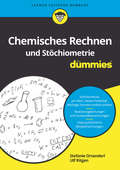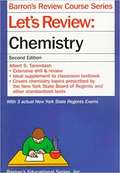- Table View
- List View
Chemiedidaktik kompakt: Lernprozesse in Theorie und Praxis
by Günther Harsch Hans-Dieter Barke Simone Kröger Annette MarohnChemiedidaktik kompakt bietet den Studierenden und Studienreferendaren des Chemielehramts praxisnahes Überblickswissen mit vielen Beispielen aus dem aktuellen Unterricht, mit Experimenten und Modellen, mit Übungsaufgaben und schulrelevanten Ergebnissen der Lehr- und Lernforschung zu jedem Thema. Die Autoren behandeln mit ihrem erprobten Konzept nicht nur die klassischen Probleme der Chemiedidaktik, sondern widmen sich auch ausführlich den modernen Themen wie Chemie im Alltag, Schülervorstellungen, Medien und Motivation.
Chemiedidaktisches Einmaleins für Berufsanfänger: Rund um das Experimentieren im Chemieunterricht
by Brigitte Duvinage Marc Sören HomeyerDieses Lehrbuch richtet sich insbesondere an Quereinsteiger für das Fach Chemie, um Ihnen für den Berufseinstieg wesentliche fachdidaktische Grundlagenkenntnisse, die in steter Wechselbeziehung mit dem Einsatz von Experimenten und dem Aufbau von Wissensstrukturen stehen, aufzuzeigen. Die damit verbundenen Kompetenzentwicklungen werden praxisrelevant in den Kapiteln diskutiert, und sie sind mühelos autodidaktisch zu erschließen. In ausgewählten Unterrichtsbausteinen werden theoretisch diskutierte Aspekte mit Blick auf den Beitrag des Experimentes und der Entwicklung rahmenplanadäquater Kompetenzen konkretisiert. Unterschiedliche Materialien für die Planung und den Unterricht sind darin eingebunden. Didaktisch-methodische Hinweise runden die Kapitel ab. Im Kapitel 14 steht das sichere und souveräne Experimentieren mit und für Lernende im Mittelpunkt. Aufgaben und Lösungen in einzelnen Kapiteln dienen der Überprüfung der eigenen Kompetenzen für die Planungsarbeit. Letztlich werden auch Referendare und Lehrende für Naturwissenschaften in diesem Buch einen nicht zu unterschätzenden Wissensfundus entdecken.
Chemielogistik: Markt, Geschaftmodelle, Prozesse
by Carsten SuntropChemielogistik bedeutet mehr als nur Lager- und Transportlogistik. In Bezug auf Sicherheit und Umweltschutz hat die Branche hohe Anforderungen zu erfüllen. Transportaufwand und Anspruch an eine spezifische Verteilung werden immer komplexer. Die Chemielogistik muss sich den wachsenden Herausforderungen der modernen globalisierten Welt stellen. Diesen Ansprüchen begegnen die Autoren, ausnahmslos Spezialisten in der Chemielogistik, mit intelligenten Investitionsmodellen - die Ideen und Ansätze zur gezielten Weiterentwicklung der Branche erstrecken sich dabei auf die Bereiche: - Markt und Wettbewerb, dem Chemielogistiker in besonderem Maße ausgesetzt sind - Unternehmensführung, wo die Geschäftsmodelle zwischen Standortlogistikern, Speziallogistikern und Konzernlogistikern erheblich differieren - Prozess- und IT-Bereich, der von den hohen und speziellen Anforderungen der Chemieindustrie geprägt ist Herausgegeben von einem führenden Experten der Chemielogistik bietet das vorliegende Buch Praktikern die ideale Hilfestellung, eigene Prozesse in der Strategie- und Unternehmensentwicklung mit neuen Ideen anzureichern. Mit aktuellen Interviews aus der Industrie (Bayer MaterialScience Customer Service GmbH, A.C.P. Logistics GmbH, Dachser GmbH & Co. KG)
Chemiepark: Anekdoten, Geschichten und Betrachtungen aus einem Chemiker-(Er-)Leben
by Günter LattermannDieses Buch ist in zwei Teile aufgeteilt und beschreibt im Ersteren anhand von köstlichen Anekdoten und Geschichten mit teilweise berühmten Leuten mein Chemiker-(Er-)Leben. Im zweiten Teil diskutiere ich die vermeintlichen „zwei Kulturen“ von Geistes- und Naturwissenschaften, Imageprobleme der Chemie, ChemikerInnen, Kunststoffen/Plastik, sowie deren mögliche Bewältigung (Rationalität und Emotion) und die gegenwärtige Plastikmüllproblematik in Zusammenhang mit der Kunststoffgeschichte. Dieses Buch ist sowohl für Leute vom Fach, als auch Nichtfachleute geeignet.
Chemiereaktoren: Auslegung und Simulation
by Jens HagenMittelpunkt eines jeden chemischen Prozesses ist der Chemiereaktor, in dem chemische Umsetzungen unter technischen und möglichst optimalen Bedingungen durchgeführt werden. Unser Buch behandelt die Grundlagen der Chemischen Reaktionstechnik und erläutert alle erforderlichen Auslegungsgleichungen auf Basis der Stoff- und Wärmebilanz unter Berücksichtigung der Stöchiometrie und Kinetik der Reaktionen. Jedes Kapitel enthält vollständig durchgerechnete Beispiele und Übungsaufgaben, für die Lösungen angegeben sind und der Lösungsweg kommentiert wird. Komplexere Aufgabenstellungen werden unter Einsatz von numerischen Verfahren mit dem Computer gelöst. Das Softwarepaket POLYMATH bietet einen sehr guten Einstieg in die Modellierung und Simulation von Chemiereaktoren - es ist besonders anschaulich und einfach zu erlernen. Mit einem einmal aufgestellten Modell lässt sich der Einfluss verschiedener Reaktionsparameter auf den Gesamtprozess leicht nachvollziehbar simulieren. Zielgerichtet wird die Modellierung von Problemstellungen geübt, und es werden verständliche Lösungswege aufgezeigt, um praxisbezogene Aufgaben zu lösen. Vorausgesetzt werden nur Grundkenntnisse in Physikalischer Chemie, insbesondere Reaktionskinetik und Mathematik (Lösung von Differentialgleichungen, Regression).
Chemiereaktoren: Grundlagen, Auslegung und Simulation
by Jens HagenKenntnisse der Auslegung und Simulation von Chemiereaktoren sind die Voraussetzung für den optimalen technischen und wirtschaftlichen Betrieb von chemischen Prozessen. In der neuen Auflage von "Chemiereaktoren" gibt Jens Hagen einen bewährten und verständlichen Einstieg in das komplexe Thema und vermittelt die Grundlagen der Reaktionstechnik. Alle erforderlichen Auslegungsgleichungen auf Basis der Stoff-, Wärme- und Impulsbilanz unter Berücksichtigung von Stöchiometrie und Kinetik der Reaktionen werden abgeleitet und erläutert. Jedes Kapitel enthält vollständig durchgerechnete Beispiele und Übungsaufgaben mit kommentierten Lösungen. Um einen Einstieg in die Modellierung und Simulation von Chemiereaktoren zu geben, nutzt Jens Hagen das Softwarepaket POLYMATH, das das Finden von numerischen Problemlösungen leicht nachvollziehbar und mit geringem Aufwand erlaubt. Zielgerichtet wird die Modellierung von Problemstellungen geübt und es werden verständliche Lösungswege aufgezeigt, um Probleme aus der Praxis zu lösen. In der zweiten Auflage wurde das Buch um die Lösung von Differenzialgleichungen zweiter Ordnung und von partiellen Differenzialgleichungen erweitert, um komplexere Fragestellungen des Stoff- und Wärmeaustauschs lösen zu können. Zusätzlich wurden viele neue Beispiele und Simulationen aufgenommen, die reale Probleme in der Reaktionstechnik widerspiegeln und eine Übertragung der Beispiele in die Praxis erleichtern.
Chemiestandorte: Markt, Herausforderungen und Geschäftsmodelle
by Carsten SuntropDieses praktisch orientierte Buch präsentiert systematisch neue und aktuelle Konzepte für Chemiestandorte. Geschrieben von einem renommierten Autorenteam aus Wissenschaft, Beratung & Praxis ist das Buch ein Muss für jedermann aus dieser Branche.
Chemiker im "Dritten Reich"
by Helmut MaierDie Gesellschaft Deutscher Chemiker (GDCh) wurde 1949 gegründet und ist heute mit über 30. 000 Mitgliedern, vorrangig aus Hochschulen und Industrie, die größte kontinentaleuropäische chemische Gesellschaft. Ihre im 19. Jahrhundert gegründeten Vorgängerorganisationen, die Deutsche Chemische Gesellschaft (DChG) und der Verein Deutscher Chemiker (VDCh), wirkten als die Motoren der so erfolgreichen Chemie in Deutschland und sind Teil des Erbes der GDCh. Dessen dunkle Seite begann man erst ab 2001 zuuntersuchen. Bis dahin sorgten auch in diesem Bereich unserer Gesellschaft existierende Kontinuitäten dafür, dass der Mantel des Schweigens über Leben und Wirken der männerbestimmten Verbände und ihrer Protagonisten gebreitet wurde. Viele Opfer des totalitären NS-Staates blieben gänzlich unbekannt. Der Wissenschaftshistoriker Helmut Maier legt nun eine eindrucksvolle, umfassende und unabhängige Studie über Funktionen und Strukturen der DChG und des VDCh von 1933 bis 1945 vor. Detailliert wird der Weg auch weniger bekannter Chemiker aus Forschung, Industrie und dem deutschen chemischenLiteraturwesen beschrieben, sowie Einzelschicksale systematisch aufgespürt und beleuchtet. Erstmals existiert ein Gesamtbild über die Berufsgruppe der Chemiker, ihre für das Dritte Reich so bedeutende Rolle und damit vor allem eine mahnende Erinnerung für alle Nachfolgegenerationen.
Chemiluminescence in Analytical Chemistry
by Ana M. Garcia-CampanaThis volume details the theories, mechanisms, technologies and trends for solving qualitative and quantitative problems in diverse areas of analytical research - emphasizing physicochemical principles. It focuses on deriving simpler and more extensive chemiluminescence (CL) detectors reflecting miniaturization trends, including narrow-bone and capi
Chemische Biologie: und Wirkstoffentwicklung
by Marco F. SchmidtIm Zentrum dieses Lehrbuchs steht die Anwendung, weniger die die reine Wissensvermittlung der Ergebnisse aller chemisch biologischer Arbeiten (was auch den Rahmen eines Buches sprengen würde). Es gibt dem Leser durch die gezielte Auswahl von chemisch-biologischen Techniken und Konzepten das nötige Rüstzeug, um in dem komplexen Spannungsfeld der Chemischen Biologie und der Wirkstoffentwicklung neue Denkweisen und damit neue Therapiemöglichkeiten entwickeln zu können. Erklärtes Ziel dieses Buches ist es, Studenten, (Post-)Doktoranden sowie erfahrenen Wissenschaftlern an Universitäten sowie in der Industrie bei ihren Problemen konkret Lösungen aufzuzeigen und sie zu inspirieren. Als roter Faden dieses Buches dienen nach einer Einführung in die Problematik, die die Chemische Biologie in der Wirkstoffentwicklung adressiert, die drei Ebenen des molekularbiologischen Dogmas: DNA, RNA und Proteine und ihre Rolle als Wirkstoffziele.
Chemische Elemente und ihre Spezies: Mobilität, Bioverfügbarkeit, Toxizität und Analytik
by Georg SchwedtDas Buch stellt Methoden und Strategien zur differenzierten Analytik und Bewertung von chemischen Elementen in Wasser, Boden und Lebensmitteln vor zum Zwecke der Bewertung von Mobilit#65533;t, Toxizit#65533;t und Bioverf#65533;gbarkeit. Denn es ist eben nicht nur die Dosis, die ein Gift zum Gift macht, sondern auch die Art der Spezies.
Chemische Experimente in Schlössern, Klöstern und Museen: Aus Hexenküche und Zauberlabor
by Georg SchwedtOb es um Tinte, Farben, Genussmittel, Zundholzer, Pharmazeutika oder gar den Stein der Weisen geht: Chemie und Kulturgeschichte sind nicht voneinander zu trennen. Besonders anschaulich wird das, wenn chemische Experimente in historischem Ambiente vorgefuhrt werden. Zwischen Rheinsberg in Brandenburg und Tettnang am Bodensee finden in Schlossern, Museen und Klostern die Experimentalvortrage statt, auf denen aufbauend dieses Buch entstand. Nun in der zweiten Auflage, sind weitere Experimente dazugekommen, die sich zum Beispiel mit Silber und Gold, Tod und Teufel beschaftigen. Die Dichte der historischen Standorte auf der Deutschlandkarte nimmt zu: vom Bergbau im Harz bis "Doktor Faustus" im Kloster Maulbronn.
Chemische Experimente in naturwissenschaftlich-technischen Museen: Farbige Feuer und feurige Farben
by Georg SchwedtGeorg Schwedt lädt Sie ein, ihn auf seiner abwechslungsreichen Reise durch ausgewählte naturwissenschaftlich-technische Museen quer durch Deutschland zu begleiten. Die Stationen seiner spannenden Reise sind: · das Bergbaumuseum Weltkulturerbe Rammelsberg Goslar, · das Deutsche Erdölmuseum Wietze, · das Deutsche Salzmuseum Lüneburg, · das Deutsche Apothekenmuseum Heidelberg, · das Landesmuseum für Technik und Arbeit Mannheim, · das Museum für Brotkultur Ulm und · das Fuhlrott-Museum & Forschungsinstitut in Wuppertal. In bewährter Manier kombiniert Georg Schwedt spannende Chemieexperimente mit interessanten Hintergrundinformationen zu den Museen und ihren vielfältigen Themenschwerpunkten. Lassen Sie sich einfangen von der Faszination, wie man mit einfachen Hilfsmitteln Chemieexperimente - ob im Museum, in der Schule oder zu Hause - nachvollziehen kann. Wie kann beispielweise aus dem Grundstoff Erdöl ein Arzneimittel hergestellt werden? Wie entsteht lockeres Brot aus den Grundzutaten Mehl, Backtriebmittel und Wasser? Und vielleicht können die Experimente Sie so fesseln, dass Sie als nächste Urlaubsreise eine Museumstour planen, um die vorgestellten Museen einmal in Natura kennen zu lernen. Oder Sie nutzen den nächsten anstehenden Schulausflug, um den fälschlich als langweilig verpönten Museumsbesuch bei Jugendlichen und Schülern zu einem attraktivem Erlebnis zu machen. Dieses Buch ist für alle Kenner der anderen "Schwedt Experimentierbücher", für naturwissenschaftlich interessierte Kulturhistoriker, für kulturhistorisch interessierte Naturwissenschaftler und natürlich für alle, die einfach gerne ins Museum gehen und dort mehr wollen als nur Exponate ansehen.
Chemische Gleichgewichte in der Analytischen Chemie: Die Theorie Der Säure-base-, Komplexbildungs-, Fällungs- Und Redoxgleichgewichte
by Heike Kahlert Fritz ScholzDas Lehrbuch beschreibt die theoretischen Grundlagen der Säure-Base-, Komplex-, Fällungs- und Redoxgleichgewichte für die Analytische Chemie, Umweltchemie und Biochemie.
Chemische Gleichgewichte in der Analytischen Chemie: Die Theorie der Säure-Base-, Komplexbildungs-, Fällungs-, Redox- und Verteilungsgleichgewichte
by Heike Kahlert Fritz ScholzDas Lehrbuch beschreibt die theoretischen Grundlagen der Säure-Base-, Komplex-, Fällungs- und Redoxgleichgewichte für die Analytische Chemie, Umweltchemie und Biochemie.
Chemische Gleichgewichte: Ein Abriss über die wichtigsten Reaktionen in wässriger Lösung (essentials)
by Susanne LangbeinSusanne Langbein hat auf Basis verschiedener Lehrb#65533;cher ein essential verfasst, das den Einstieg in die chemischen Gleichgewichte erleichtern soll. Mit dem zugrunde liegenden Konzept ,von Studenten f#65533;r Studenten' erl#65533;utert sie Sachverhalte rund um die Themen ,Das chemische Gleichgewicht', ,S#65533;ure-Base-Reaktionen' und ,Redoxreaktionen' einfach und anschaulich. Dabei legt die Autorin besonderen Wert darauf, dass jedermann mit Grundwissen in Chemie in das Themengebiet eintauchen und sich einen guten #65533;berblick #65533;ber die wichtigsten Reaktionen in w#65533;ssriger L#65533;sung sowie die Prinzipien und Regeln, auf denen diese Reaktionen beruhen, verschaffen kann.
Chemische Grundlagen der Geo- und Umweltwissenschaften
by Robin GillChemische Grundlagen sind die Basis für einen großen Teil der Geowissenschaften. Studierende der Geowissenschaften benötigen daher zunehmend ein solides Verständnis der chemischen Grundlagen, um ihr Studium erfolgreich zu absolvieren. Die erweiterte zweite Auflage dieses beliebten Lehrbuchs führt die Studenten in diese "georelevante" Chemie ein, die in demselben klaren und verständlichen Stil wie die Vorauflage präsentiert wird. Die neue Auflage wurde jedoch um den Bereich der Umweltgeowissenschaften erweitert und enthält ein neues Kapitel, in dem die Isotopengeochemie vorgestellt wird.Das Buch umfasst drei große, gegliederte Teile. Der erste (Kapitel 1-4) befasst sich mit der grundlegenden physikalischen Chemie geologischer Prozesse. Der zweite Teil (Kapitel 5-8) führt in die wellenmechanische Sicht auf das Atom ein und erklärt die verschiedenen Arten chemischer Bindungen, die den Materialien der Erde ihre vielfältigen und charakteristischen Eigenschaften verleihen. Die Schlusskapitel (9-11) geben einen Überblick über die geologisch relevanten Elemente und Isotope und erklären ihre Entstehung und ihre Häufigkeit im Kosmos und auf der Erde. Das Buch schließt mit einem umfangreichen Glossar von Begriffen; die Anhänge behandeln grundlegende Mathematik, erklären die grundlegende Lösungschemie und listen die chemischen Elemente und die im Buch verwendeten Symbole, Einheiten und Konstanten auf.Die Übersetzung wurde mit Hilfe von künstlicher Intelligenz (maschinelle Übersetzung durch den Service DeepL.com) angefertigt. Da die anschließende Überprüfung hauptsächlich im Hinblick auf inhaltliche Gesichtspunkte erfolgte, kann sich der Text des Buches stilistisch von einer konventionellen Übersetzung unterscheiden. Springer Nature arbeitet bei der Publikation von Büchern kontinuierlich mit innovativen Technologien, um die Arbeit der Autoren unterstützen.
Chemische Grundlagen der Pyrotechnik
by Georg SchwedtNach Darstellungen zur Geschichte der Lustfeuerwerkerei werden die grundlegenden chemischen Prinzipien und Vorgänge der pyrotechnischen Effekte vorgestellt - von der Wunderkerze bis zu den funkensprühenden Raketen.
Chemische Reaktionen in der Wasseranalyse
by Rolf PohlingDieses Buch ist dem Praktiker eine Hilfe in der Wasseranalyse. Es erläutert die chemischen Reaktionen und Zusammenhänge, z. B. warum sich eine Lösung durch Zugabe eines spezifischen Reagenzes färbt, es werden aber auch die Reaktionen zur Beseitigung von Störungen aufgezeigt. Es können in der Analyse auch mehrere Störungen auftreten. Damit verfügt der Wasseranalytiker über eine Ergänzung zu seinem analytischem Vorschriftenbuch. Insgesamt kann dabei ein beträchtliches theoretisches Rüstzeug erarbeitet werden, das nicht nur für die Wasseranalyse von Bedeutung ist. Es sind 40 Parameter in alphabetischer Reihenfolge aufgezeigt, in denen bis zu 10 Methoden des Parameters als chemische Reaktionen und mit ihren organischen Strukturen aufgeführt sind. Zusätzlich sind Vorkommen, Herkunft und Bedeutung der Verschmutzungsparameter beschrieben. Das Buch trägt damit erheblich zum Verständnis der Wasseranalyse bei und darf in keinem Labor fehlen, in dem Wasseranalysen durchgeführt werden.
Chemische Reaktionstechnik
by Gerhard Emig Elias Klemm Hannsjörg FreundDieses Werk ist ein bewährter Lehrbuch-Klassiker im Bereich der Technischen Chemie. Als vollständige Einführung in das Fachgebiet der Chemischen Reaktionstechnik unterstützt es in idealer Weise sowohl das akademische Studium als auch die Arbeit in der industriellen Praxis. Es ist für die Fachrichtungen Chemieingenieurwesen, Chemie und Verfahrenstechnik gleichermaßen geeignet und wird seit vielen Jahren im Lehrprofil Technische Chemie der DECHEMA empfohlen.Mit dieser Neuauflage erfolgte eine leichte Überarbeitung und die Ergänzung eines neuen Kapitels zur elektrochemischen Reaktionstechnik. Gliederung und Struktur des Lehrbuchs haben sich bewährt und wurden beibehalten.
Chemische Reaktionstechnik: Einfuhrung In Die Chemische Reaktionstechnik (Springer-Lehrbuch)
by Gerhard Emig Elias KlemmDie neue vollständig überarbeitete Auflage dieses schon klassischen Lehrbuches berücksichtigt vor allem den Einsatz moderner Methoden in der chemischen Reaktionstechnik sowie die Entwicklungstendenzen im Bereich Modellierung und damit in der Computeranwendung. Dies ist auch der Grund, weshalb ein weiterer Autor aus dem aktiven Hochschuldienst das Autorenteam ergänzt. Im einzelnen wurden folgende Teile neu aufgenommen: - Fluid-Fluid-Reaktionen - Stöchiometrie chemischer Reaktionen - Wirbelschichtreaktoren - Stark erweiterter mathematischer Anhang, zugeschnitten auf den Computereinsatz - Symbolverzeichnis
Chemische Spielereien: Kreative Ideen für kleine und große Forscher
by Kathrin DegenVom Eiswürfelkran zum selbst gemachten Christbaumschmuck: mehr als 50 originelle Versuche zu den Grundlagen der Chemie mit Bildanleitung und kindgerechter Erklärung wecken auf spielerische Weise das Interesse an der Natur und an der Wissenschaft.
Chemisches Praktikum für Mediziner (Studienbücher Chemie)
by Gerhard Hilt Peter RinzeDas Chemische Praktikum stellt für Studierende der Medizin und der Zahnmedizin einen wichtigen Abschnitt in ihrer vorklinischen Ausbildung dar. In ihm werden praktische Kenntnisse über experimentelles Arbeiten vermittelt. Die Versuche umfassen chemische Umsetzungen und analytische Verfahren, die die Grundlagen biochemischer und physiologischer Laborarbeiten bilden. Gleichzeitig führt die praktische Beschäftigung mit der Chemie auch zur Vertiefung der in Vorlesungen und Übungen erarbeiteten theoretischen Kenntnisse. In 65 Aufgaben an elf Kurstagen werden Gesetze und Modellvorstellungen der Chemie exemplarisch erarbeitet. Dabei wird auch auf den sicheren Umgang mit Gefahrstoffen und deren Entsorgung aus der Sicht der Gefahrstoffverordnung und des Umweltschutzes eingegangen.
Chemisches Rechnen und Stöchiometrie für Dummies (Für Dummies)
by Stefanie Ortanderl Ulf RitgenStöchiometrie, Stoffmengen und Konzentrationsangaben, Massen und Ausbeuten, Redox-Potentiale, pH-Werte: Gelegentlich müssen Sie in der Chemie auch rechnen. Derlei Berechnungen sind wirklich einfach und einleuchtend, wenn Sie erst einmal wissen, welche Formel(n) Sie wann verwenden müssen ? und warum eigentlich. Genau das gilt es zu üben, und dabei hilft Ihnen dieses Buch: Die jeweils notwendigen Formeln werden vorgestellt, Sie erfahren, worum es dabei eigentlich geht, und jeder einzelne Rechenschritt wird nachvollziehbar und an realitätsnahen Beispielen aufbereitet. Die üblichen Fallstricke (und wie Sie diese vermeiden) werden ebenso ein Thema sein wie der Umgang mit tabellierten Werten ? und was diese eigentlich aussagen.
Chemistry
by Albert S. TarendashHere is a thorough review focused especially to prepare high school students to do well in introductory chemistry. The book gives special emphasis to the New York State Regents Chemistry exam, and covers all the materials contained in the New York State Regents Chemistry core. The author points out the structure and logic of chemical formulas and equations, reviews the phases of matter, atomic structure, chemical periodicity and chemical bonding. Other topics include organic chemistry, the mathematics of chemistry, thermodynamics, acids and bases, electrochemistry, kinetics and equilibrium, and more. A final chapter details procedures for laboratory activities. The book contains actual New York State Regents exams.
